What Is the 1995 Lincoln Penny Made Of?
The 1995 Lincoln penny is made of 97.5% zinc and 2.5% copper. It has a face value of one cent, a mass of 2.5 grams, a diameter of 19.05 millimeters, a thickness of 1.52 millimeters, and a plain edge.
Victor David Brenner designed the 1995 Lincoln penny’s obverse while Frank Gasparro designed the reverse.
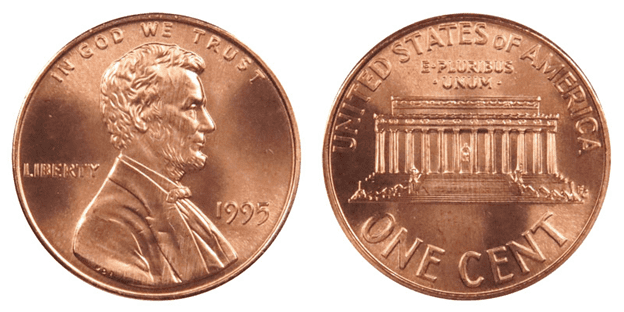
The obverse has the right profile of Abraham Lincoln. The inscriptions include the following:
- IN GOD WE TRUST
- LIBERTY
- 1995
- Mint mark (D, S, or none)
- Designer’s initials (VDB)
The reverse features the front view of the Lincoln memorial. The inscriptions include the following:
- UNITED STATES oF AMERICA
- E PLURIBUS UNUM
- ONE CENT
- Designer’s initials (FG)
The Lincoln penny was first issued in 1909 and since then, the penny has always featured the face of Lincoln. However, it was only on the sesquicentennial birth anniversary of Lincoln, 1959, that the Lincoln Memorial was added to the reverse.
In 2009, the Lincoln Memorial was replaced with four different reverse designs. In 2010, a new and more permanent reverse was introduced. It was the Union Shield designed by Lyndall Bass.
The US Treasury officially named this coin the “one cent piece.” On the other hand, the US Mint officially called it “cent.” The term penny was derived from the British coin.
Starting in 2010, the US Mint reported that the raw materials used to produce the Lincoln penny are getting more expensive. In fact, the price peaked at more than $0.02. This means that the face value of the penny is lower than its raw material.
The US Mint is contemplating to discontinue the Lincoln penny or at least find cheaper raw materials. At the time of this writing, there’s no final decision yet.
1995 Lincoln Penny Varieties
The 1995 Lincoln penny comes in different varieties. The varieties primarily differ in where the coin was struck and what mint mark the coin has. Aside from the standard varieties, there are also error Lincoln cents that give rise to a different type.
The three US Mints responsible for producing 1995 Lincoln pennies are the Denver, Philadelphia, and San Francisco minting centers. Here are some of the most common 1995 Lincoln cent coins:
1995 D Lincoln Penny
Year of minting: 1995
Mint Mark: D
Place of minting: Denver
Quantity produced: 7,128,560,000
Face Value: $0.01 (one cent)
Price: $0.01 to $1.00 (or more)
Mass: 2.5 grams
Edge: Plain
Designer: Victor D. Brenner (obverse) / Frank Gasparro (reverse)
Composition: 97.5% zinc and 2.5% copper
Diameter: 19.05 mm
Thickness: 1.52 mm

With 7,128,560,000 struck coins, the Denver Mint produced the most number of 1995 pennies. These pennies have the D mint mark and you can sell or buy them starting from $0.01 up to $1.00. The Lincoln penny can be more expensive when sold in the open market.
1995 P Lincoln Penny
Year of minting: 1995
Mint Mark: None
Place of minting: Philadelphia
Quantity produced: 6,411,440,000
Face Value: $0.01 (one cent)
Price: $0.01 to $9.00 (or more)
Mass: 2.5 grams
Edge: Plain
Designer: Victor D. Brenner (obverse) / Frank Gasparro (reverse)
Composition: 97.5% zinc and 2.5% copper
Diameter: 19.05 mm
Thickness: 1.52 mm
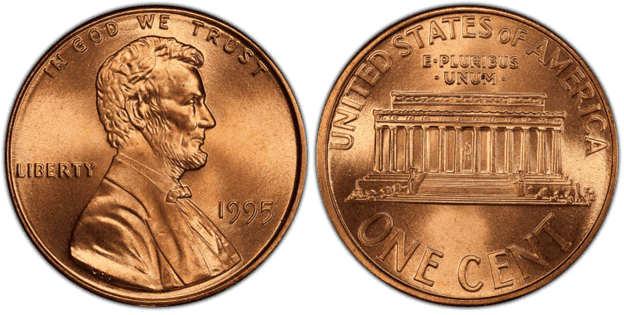
The Philadelphia Mint produced more than 6.4 billion Lincoln pennies in 1995. Traditionally, the Philadelphia Mint doesn’t put a mint mark on the coins they have produced. Thus, you’ll see that the 1995-P penny doesn’t have a mint mark. This 1995 variety is deemed to be more valuable than the other usual varieties. On average, you can sell this coin from $0.01 to $9.00.
1995 S Lincoln Penny
Year of minting: 1995
Mint Mark: S
Place of minting: San Francisco
Quantity produced: 2,797,481
Face Value: $0.01 (one cent)
Price: $0.01 to $1.00 (or more)
Mass: 2.5 grams
Edge: Plain
Designer: Victor D. Brenner (obverse) / Frank Gasparro (reverse)
Composition: 97.5% zinc and 2.5% copper
Diameter: 19.05 mm
Thickness: 1.52 mm
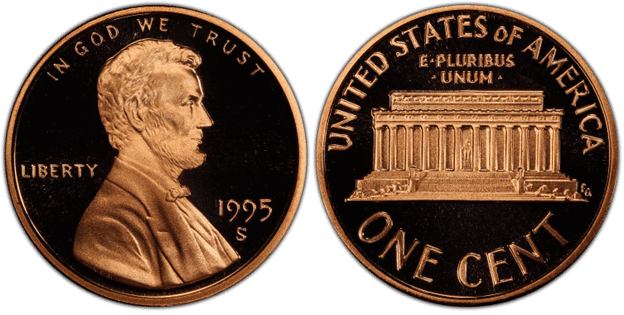
There were only 2,797,481 Lincoln pennies produced in 1995 by the San Francisco Mint. This figure is significantly lower than what the other minting centers produced.
The main reason is that the San Francisco Mint produced proof coins, which are meant to be given to collectors rather than for circulation. Proof coins are more detailed and beautiful to behold.
List Of 1995 Lincoln Penny Errors
There are billions of 1995 Lincoln pennies. Thus, it should not be a surprise to see that there are error coins in this series.
Errors may happen due to the faulty condition of the die and planchet. It can also happen when there’s a weak or off-center strike. Plus, human errors may also contribute to its occurrences.
To give you an idea, here’s an example of a 1995 penny with a doubled die strike on the obverse side:
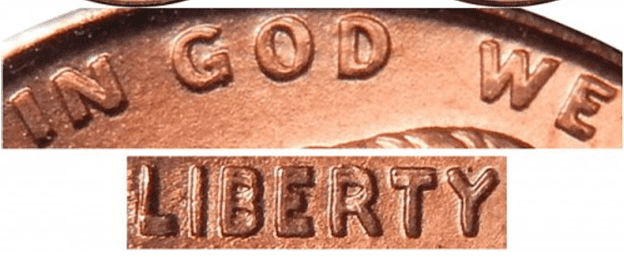
As you can see above, there’s a doubling in the letters of “LIBERTY” and “IN GOD WE.” Doubled die errors occur when the die or hub is misaligned, resulting in duplicate design elements.
While there are several ways that designs can be misaligned, there are eight main classes of doubled die errors:
- Class 1, Rotated – this error occurs when the die rotates in a clockwise or counterclockwise direction
- Class 2, Distorted – distorted errors happen when the design moves toward the edge of the coin
- Class 3, Design – class 3 errors happen when a hub with a different design gets stamped over the intended design
- Class 4, Offset – as its name suggests, offset errors occur when the second hubbing is misaligned in an offset direction
- Class 5, Pivoted – pivoted errors happen when the hub was accidentally rotated with a pivot point near the rim
- Class 6, Distended – class 6 errors occur when the hub is distended or stretched out
- Class 7, Modified – this happens when a hub is modified before additional hubbings (e.g. design elements were changed)
- Class 8, Tilted – class 8 errors happen when the die or hub is tilted incorrectly
What’s interesting is that this error can make the coin multiple times more expensive than its face value. For example, if you have an uncirculated 1995 penny with this error and your coin is still in good condition, you can sell it for more than $50.
Some of the common errors as well would involve the quality of the strike on the coin. In this example, you’ll see that the coin is slightly clipped and the strike was off-center. This usually happens when the Lincoln cent assumes an elliptical shape because the strike caused it to be torn off or sheared in two.
Here’s an example of this error:
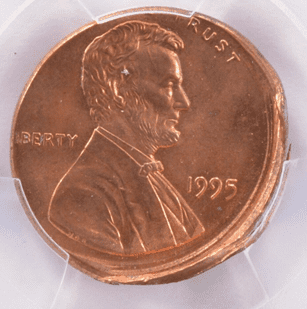
Here’s another good example of an off-center strike:
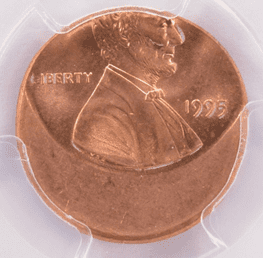
The inaccurate strike caused the coin to have a crescent moon-like appearance. Off-center strikes may happen when the planchet wasn’t positioned properly or it was loosely placed on the striking spot.
How Much Is the 1995 Lincoln Penny Worth Today?
The face value of the 1995 Lincoln penny is $0.01. The melt value is even lower at $0.0070. As this might be the case, there are 1995 Lincoln pennies that are still more expensive than others.
Here’s a 1995 Lincoln Penny values chart to help you learn more about its price:
| Coin | Condition | Grade | Mintage | Value |
| 1995 D Lincoln penny | Circulated/mint | Not graded | 7,128,560,000 | $0.01 to $1.00 |
| 1995 D Lincoln penny | Uncirculated/mint | MS-67 | 7,128,560,000 | $10 to $35 |
| 1995 D Lincoln penny | Uncirculated/mint | MS-68 | 7,128,560,000 | $61 to $180 |
| 1995 D Lincoln penny | Uncirculated/mint | MS-69 | 7,128,560,000 | $960 |
| 1995 P Lincoln penny | Circulated/mint | Not graded | 6,411,440,000 | $0.01 to $9.00 |
| 1995 P Lincoln penny | Uncirculated/mint | MS-66 | 6,411,440,000 | $6 to $16 |
| 1995 P Lincoln penny | Uncirculated/mint | MS-67 | 6,411,440,000 | $12 to $132 |
| 1995 P Lincoln penny | Uncirculated/mint | MS-68 | 6,411,440,000 | $25 to $149 |
| 1995 S Lincoln penny | Uncirculated/proof | Not graded | 2,797,481 | $0.01 to $1.00 |
| 1995 S Lincoln penny | Uncirculated/proof | PR-68 | 2,797,481 | $9 to $45 |
| 1995 S Lincoln penny | Uncirculated/proof | PR-69 | 2,797,481 | $8 to $15 |
| 1995 S Lincoln penny | Uncirculated/proof | PR-70 | 2,797,481 | $30 to $100 |
How Does The Grading System Work?
The Sheldon Scale is used by numismatists to provide a numerical value to coins. The Sheldon Scale goes from poor (P-1) to perfect mint state (P-1) (MS-70). Coins were originally evaluated using words to reflect their condition (Good, Fair, Excellent, Etc.). Unfortunately, coin collectors and dealers had different ideas about what each of these terms represent.
Professional numismatists joined together in the 1970s and established CoinGrading standards. These numismatists now assign grades at key places on the seventy-point scale, using the most regularly utilized numeric points in conjunction with the original adjective grade. The following are the most common coin grades:
-
-
- (P-1) Poor – Indistinguishable and probably damaged; if used, must have a date and mintmark; otherwise, rather battered.
- (FR-2) Fair – Nearly smooth, but without the damage that a coin graded Poor often possesses. The coin must have enough detail to be identified.
- (G-4) Fair – Inscriptions have merged into the rims in some areas, and important elements have been mostly erased.
- (VG-8) Very Good- A little weathered, but all of the primary design elements are visible, albeit faintly. There is little if any, central detail left.
- (F-12) Good – The item is very worn, yet the wear is even, and the overall design details stand out clearly. Rims are almost completely isolated from the field.
- (VF-20) Very Fine – Moderately weathered, with some finer features still visible. The motto or all letters of LIBERTY are readable. Both sides of the coin have entire rims that are separated from the field.
- (EF-40) Extremely Fine – Gently used; all gadgets are visible, and the most important ones are bold. The finer details are bold and clear, however, light wear may be seen.
- (AU-50) Uncirculated – Slight evidence of wear on the coin’s design’s high points; may have contact marks; eye appeal should be adequate.
- (AU-58) Uncirculated Choice – Slight traces of wear, no severe contact marks, almost full mint shine, and great eye appeal.
- (MS-60) Mint State Basal – Strictly uncirculated; no indication of wear on the coin’s highest points, but an unsightly coin with reduced luster, visible contact marks, hairlines, and other flaws.
- (MS-63) Mint State Acceptable – Uncirculated, but with contact scratches and nicks, little reduced shine, but otherwise appealing appearance. The strike is weak to average.
- (MS-65) Mint State Choice – Uncirculated with great mint shine, very little contact blemishes, and exceptional eye appeal. The strike is unusually severe.
- (MS-68) Mint State Premium Quality – Uncirculated with superb luster, no obvious contact marks to the naked eye, and exceptional eye appeal. The strike is quick and appealing.
- (MS-69) Almost Perfect Mint State – Uncirculated with perfect brilliance, a sharp and appealing strike, and extremely good eye appeal. A near-perfect coin with minor imperfections in the planchet, strike, and contact markings (seen only under 8x magnification).
- (MS-70) Mint State Perfect – Under 8x magnification, there are no tiny imperfections discernible; the strike is crisp, and the coin is perfectly centered on a beautiful planchet. Rarely seen on a coin, this coin is bright and whole, with original luster and exceptional eye appeal.
-
Are There Any Rare 1995 Lincoln Pennies?
Yes, there are rare 1995 Lincoln pennies. One of the best examples is the doubled die error. Because the coin was struck twice, there’s a doubling of some elements. There’s no official count of how many doubled-die Lincoln pennies are out there. The 1995 Lincoln coin with no mint mark and doubled die error can cost at least $50.
Aside from that, 1995 Lincoln pennies with grades of at least MS 66 and PR 67 are considered rare as well. Only a few Lincoln pennies are given this high grade.
Where To Buy Or Sell 1995 Lincoln Penny?
The 1995 Lincoln penny can be bought online or in brick-and-mortar shops. Online websites such as USA Coin Book, Grey Sheet, and Coin Appraiser specialized in buying and selling coins. There are also online selling platforms such as eBay, Amazon, Etsy, and Facebook Marketplace that you can use.
Moreover, the US Mint also sells coins. You can go to them and see if they have 1995 Lincoln pennies. If not, they can refer you to places where you can.
Coin and antique shops are great choices as well. If you’re right on time, you can find some of the rarest Lincoln pennies from these places. If you have time, join auctions. Heritage Auction in Florida is best known for selling rare and beautiful Lincoln pennies.
FAQs
How much is a 1995 Penny (No Mint Mark) worth?
The 1995 penny with no mint mark is $0.01 in value. However, if you have the 1995 penny with doubled die error, the price can easily reach to at least $50.
How to tell if my 1995 penny is a doubled die?
Look into the small details of your 1995 penny. A doubled die coin will have a doubling effect on the letters and other elements. For example, look closely at the word, “LIBERTY.” You’ll find what seems to be a shadow, which is a sign that the coin was struck twice.
What’s special about the 1995 penny?
A 1995 penny becomes special if it is rare and still in good condition. 1995 pennies that underwent coin grading would also be special if it received a high grade.
